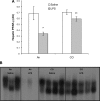Ketamine-induced hepatoprotection: the role of heme oxygenase-1
- PMID: 19372106
- PMCID: PMC2697945
- DOI: 10.1152/ajpgi.00038.2009
Ketamine-induced hepatoprotection: the role of heme oxygenase-1
Abstract
Lipopolysaccharide (LPS) causes hepatic injury that is mediated, in part, by upregulation of inducible nitric oxide synthase (iNOS) and cyclooxygenase-2 (COX-2). Ketamine has been shown to prevent these effects. Because upregulation of heme oxygenase-1 (HO-1) has hepatoprotective effects, as does carbon monoxide (CO), an end product of the HO-1 catalytic reaction, we examined the effects of HO-1 inhibition on ketamine-induced hepatoprotection and assessed whether CO could attenuate LPS-induced hepatic injury. One group of rats received ketamine (70 mg/kg ip) or saline concurrently with either the HO-1 inhibitor tin protoporphyrin IX (50 micromol/kg ip) or saline. Another group of rats received inhalational CO (250 ppm over 1 h) or room air. All rats were given LPS (20 mg/kg ip) or saline 1 h later and euthanized 5 h after LPS or saline. Liver was collected for iNOS, COX-2, and HO-1 (Western blot), NF-kappaB and PPAR-gamma analysis (EMSA), and iNOS and COX-2 mRNA analysis (RT-PCR). Serum was collected to measure alanine aminotransferase as an index of hepatocellular injury. HO-1 inhibition attenuated ketamine-induced hepatoprotection and downregulation of iNOS and COX-2 protein. CO prevented LPS-induced hepatic injury and upregulation of iNOS and COX-2 proteins. Although CO abolished the ability of LPS to diminish PPAR-gamma activity, it enhanced NF-kappaB activity. These data suggest that the hepatoprotective effects of ketamine are mediated primarily by HO-1 and its end product CO.
Figures







Similar articles
-
Ketamine attenuates liver injury attributed to endotoxemia: role of cyclooxygenase-2.Surgery. 2005 Aug;138(2):134-40. doi: 10.1016/j.surg.2005.03.024. Surgery. 2005. PMID: 16153419
-
Differential effects of anesthetics on endotoxin-induced liver injury.J Trauma. 2005 Apr;58(4):711-6; discussion 716-7. doi: 10.1097/01.ta.0000159245.60495.00. J Trauma. 2005. PMID: 15824646
-
The anti-inflammatory role of heme oxygenase-1 in lipopolysaccharide and cytokine-stimulated inducible nitric oxide synthase and nitric oxide production in human periodontal ligament cells.J Periodontol. 2009 Dec;80(12):2045-55. doi: 10.1902/jop.2009.090145. J Periodontol. 2009. PMID: 19961388
-
Induction of heme oxygenase-1 improves impaired intestinal transit after burn injury.Surgery. 2007 Mar;141(3):385-93. doi: 10.1016/j.surg.2006.06.023. Epub 2006 Sep 20. Surgery. 2007. PMID: 17349851
-
Ketamine reduces LPS-induced HMGB1 via activation of the Nrf2/HO-1 pathway and NF-κB suppression.J Trauma Acute Care Surg. 2015 Apr;78(4):784-92. doi: 10.1097/TA.0000000000000588. J Trauma Acute Care Surg. 2015. PMID: 25807407
Cited by
-
Effect of Subanesthetic Dose of Esketamine on Liver Function Following Microvascular Reconstruction for Head and Neck Cancer: A Randomized Controlled Trial.Drug Des Devel Ther. 2025 May 15;19:3971-3981. doi: 10.2147/DDDT.S505020. eCollection 2025. Drug Des Devel Ther. 2025. PMID: 40391178 Free PMC article. Clinical Trial.
-
Lack of effect of oral administration of resveratrol in LPS-induced systemic inflammation.Eur J Nutr. 2011 Dec;50(8):673-80. doi: 10.1007/s00394-011-0178-3. Epub 2011 Mar 4. Eur J Nutr. 2011. PMID: 21373948
-
Ketamine and peripheral inflammation.CNS Neurosci Ther. 2013 Jun;19(6):403-10. doi: 10.1111/cns.12104. Epub 2013 Apr 10. CNS Neurosci Ther. 2013. PMID: 23574634 Free PMC article. Review.
References
-
- Adams SD Ketamine attenuates LPS-induced liver injury via a PPAR transcription pathway. J Surg Res 130: 213, 2006.
-
- Anderson KE, Simionatto CS, Drummond GS, Kappas A. Tissue distribution and disposition of tin-protoporphyrin, a potent competitive inhibitor of heme oxygenase. J Pharmacol Exp Ther 228: 327–333, 1984. - PubMed
-
- Angus DC, Linde-Zwirble WT, Lidicker J, Clermont G, Carcillo J, Pinsky MR. Epidemiology of severe sepsis in the United States: analysis of incidence, outcome, and associated costs of care. Crit Care Med 29: 1303–1310, 2001. - PubMed
-
- Attuwaybi BO, Hassoun HT, Zou L, Kozar RA, Kone BC, Weisbrodt NW, Moore FA. Hypothermia protects against gut ischemia/reperfusion-induced impaired intestinal transit by inducing heme oxygenase-1. J Surg Res 115: 48–55, 2003. - PubMed
Publication types
MeSH terms
Substances
Grants and funding
LinkOut - more resources
Full Text Sources
Medical
Research Materials

